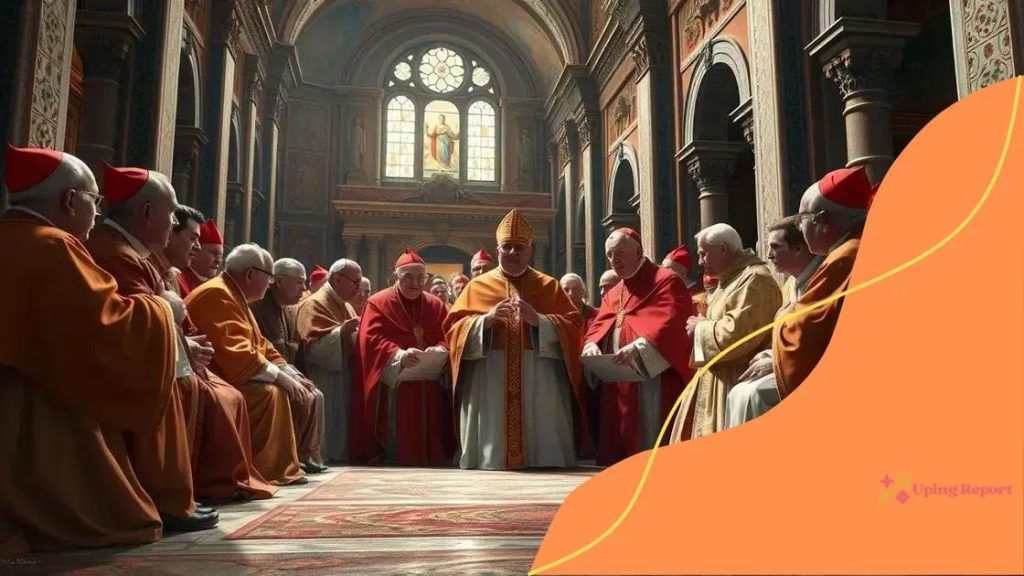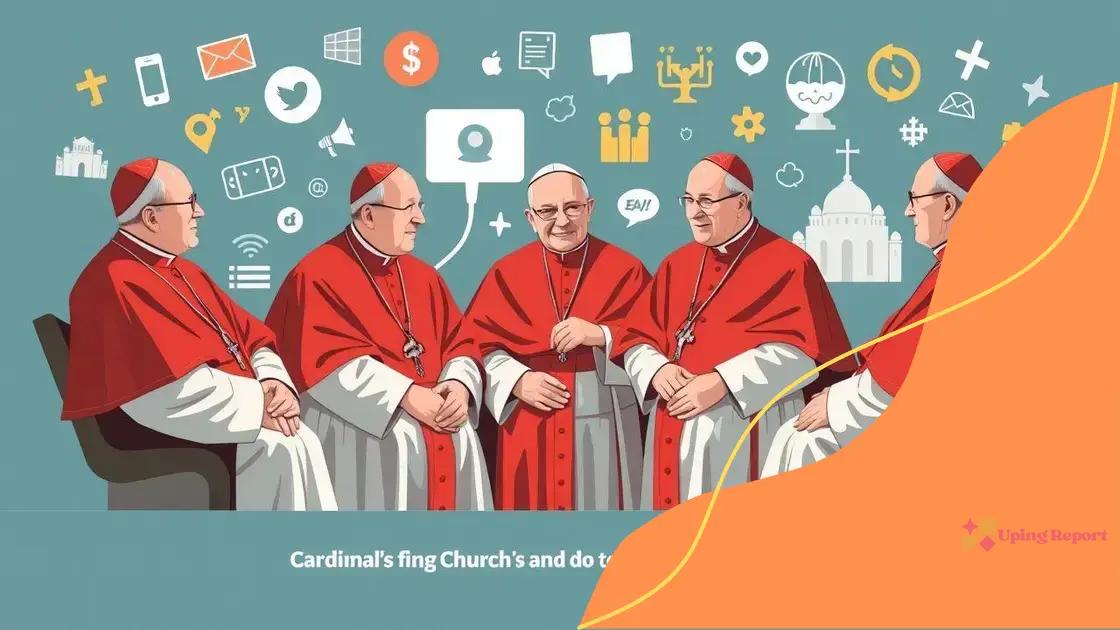Papal conclave developments: what to expect next

Papal conclave developments significantly influence the future of the Church by determining new leadership, focusing on inclusivity, engaging youth, and addressing pressing social issues.
Papal conclave developments are capturing attention as the Church faces pivotal moments. Each conclave holds the promise of change and new leadership. Are you curious about what these changes could mean for believers and the Church’s direction?
Understanding the papal conclave process
The papal conclave process is a fascinating and crucial part of selecting a new Pope. It involves various steps that ensure a careful and thoughtful decision is made by the Cardinals.
The Steps of the Conclave
First, it is important to understand how the conclave unfolds. When a Pope dies or resigns, a conclave is convened to elect a new leader. This event takes place in the Vatican City.
Cardinals from around the world gather in secrecy. Their discussions and voting happen behind closed doors. The entire process is rich in tradition and symbolism. Each step is carefully crafted to ensure fairness and respect for the office of the Pope.
Key Aspects of the Process
- The characteristics of the conclave include solemnity and respect.
- Voting occurs multiple times, often requiring several rounds before a new Pope is chosen.
- Black smoke signals are used to indicate that no decision has been reached, while white smoke announces a new Pope.
During the conclave, the Cardinals reflect deeply on their responsibilities. They are not just choosing a leader; they are deciding the future direction of the Church. This moment can change the course of history.
After weeks of intensive discussion, the Cardinals may arrive at a consensus. Once a candidate receives the required votes, they will be called to the front, where they accept the role. The announcement of the new Pope is one of the most significant moments for the Catholic community.
Understanding the papal conclave process gives us insight into the depth of the decision-making involved. The collective wisdom of the Cardinals guides the Church in turbulent times. Every conclave is unique, reflecting the contemporary issues faced by the Church.
Key figures involved in the conclave
Understanding the key figures involved in the conclave is essential for grasping how the papal election takes place. The conclave is not just a gathering; it is a significant event filled with powerful individuals who play crucial roles.
The Cardinals
The most important figures in the conclave are the Cardinals. They are appointed by the Pope and come from various parts of the world. Each Cardinal brings unique perspectives and insights to the process. Their experience and theological views are vital in determining the new leader of the Church.
The Cardinals participate in discussions and vote on the candidates. They are tasked with evaluating each other’s qualifications and spirituality, which requires a great deal of trust amongst them. This dynamic can shape the future of the Catholic Church.
Observers and Assistants
While the Cardinals are the primary decision-makers, there are also observers and assistants present during the conclave. They help facilitate the process without participating in the voting themselves. These individuals often include theologians, advisors, and staff. Their roles can be pivotal in organizing discussions and providing support to the Cardinals.
- The presence of media adds another layer, though they are kept at a distance.
- Security personnel ensure the integrity and safety of the conclave.
- They help maintain the secrecy that surrounds the voting process.
Interpersonal relationships among the Cardinals often influence the outcome. Certain Cardinals may have alliances that impact their votes. As a result, the balance of power can shift quickly during discussions. These dynamics are crucial in understanding how a Pope is selected.
The key figures involved in the conclave all share a common goal: to select a Pope who can lead the Church through challenges and inspire faith among its followers. Each person’s contribution helps shape the future direction of Catholicism.
Recent developments and their implications

The world is watching as recent developments in the papal conclave process unfold. With each gathering of the Cardinals, there are discussions that could lead to significant change within the Church.
Current Context
The latest conclave has drawn attention not just for its secrecy but also for the pressing issues the Church faces today. There are increasing calls for reform, which could guide the direction of the new Pope. The atmosphere is charged, with many hoping for a leader who will address modern challenges.
Factors such as public opinion and the ongoing global crises weigh heavily on the Cardinals’ minds. They understand that the choice they make could either solidify the Church’s influence or lead to a decline in its relevance.
Implications of the New Pope
- The new Pope may prioritize transparency, fostering greater trust among Catholics.
- Social issues are likely to influence Church policy, encouraging a more inclusive approach.
- A focus on youth engagement could reshape the way the Church interacts with younger generations.
These implications are critical. The decisions made in the conclave will affect how the Church is perceived worldwide. The potential for reform is immense, creating both hope and apprehension.
After the election, many will look for signs of change. The new leader’s stance on key issues will be scrutinized closely. Every action taken by the Pope can have rippling effects that reach across borders.
With these recent developments, it is clear that the future of the Church hangs in the balance. The Cardinals have a heavy responsibility as they deliberate. Their decisions will not only shape the Church’s policies but also impact its followers worldwide.
Media coverage of the conclave
Media coverage of the conclave plays a significant role in shaping public perception. As the Cardinals gather to elect a new Pope, journalists worldwide are eager to report on every detail.
The Role of the Media
News outlets cover the conclave from various angles, providing insights into the motivations and backgrounds of the Cardinals. This coverage can influence how people view the Church and its direction. The media’s presence amplifies the significance of the event, drawing attention from millions.
As the election process unfolds, live updates and analysis become crucial for keeping the public informed. Television broadcasts, online articles, and social media posts create a real-time narrative that captures the drama and tension of the conclave.
Types of Coverage
- Live broadcasts from the Vatican showcase key moments, like the moment the new Pope is announced.
- Interviews with religious experts offer context and predictions on potential outcomes.
- Detailed analyses explore the implications of different candidates and their past actions.
However, this extensive media coverage also brings challenges. It can lead to sensationalism and speculation, affecting the perception of the Cardinals and the decision-making process. Accurate reporting is essential, but the pressure to deliver breaking news can sometimes lead to misinformation.
News outlets strive to balance excitement with responsibility. They aim to inform the public while respecting the sanctity of the conclave. The focus remains on the principles of the Church and the importance of the election.
In the digital age, social media has amplified the immediacy of reporting. News on platforms like Twitter can reach audiences quickly, often before traditional media can respond. This creates an environment where opinions and rumors can spread rapidly.
Future expectations for the Church
The future expectations for the Church are a topic of great interest. As new leadership emerges from the papal conclave, many wonder what changes may arise.
Potential Directions
With a new Pope, the direction of the Church could shift significantly. Many expect a focus on inclusivity and addressing modern social issues. This might include topics such as poverty, climate change, and human rights. The Church has a unique opportunity to engage with these pressing matters and show relevance to its followers.
Engaging the Youth
A potential key area of emphasis is the engagement of younger generations. To do this, the Church may adopt new methods of communication and outreach. Utilizing technology and social media could help the Church connect better with youth.
- Encouraging open discussions about faith and doubt.
- Organizing events that resonate with young people’s concerns.
- Providing resources for spiritual growth in contemporary settings.
Many believe these steps can revitalize the Church and attract a new audience. The energy of the youth can breathe new life into the traditions of the Church.
Moreover, adapting services to be more community-oriented can foster a sense of belonging. With an emphasis on compassion and understanding, the Church can create a welcoming environment for everyone.
Overall, these future expectations are rooted in optimism. The new leadership might steer the Church towards a more engaged and active role in society. Embracing change while respecting tradition could help reshape perceptions and restore faith in the institution.
FAQ – Frequently Asked Questions about the Papal Conclave and Church Future
What role do the Cardinals play in the conclave?
The Cardinals are the key decision-makers who gather to elect a new Pope, evaluating candidates based on their qualifications and spiritual leadership.
How does media coverage affect the conclave?
Media coverage plays a significant role by shaping public perception and keeping people informed about the events and discussions taking place during the conclave.
What are the main expectations for the Church’s future?
Main expectations include increased inclusivity, engaging the youth, and addressing social issues to remain relevant in modern society.
How can the Church adapt to connect with younger generations?
The Church can adapt by utilizing technology and social media to reach and engage younger audiences effectively.
